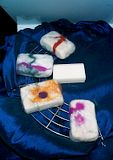
Click title to See the Museum Video about the making of this spider silk tapestry with traditional motifs! Half a million dollars were spent tho- how crazy!
Musings of a Knitting Spinning Felting Dyeing Braiding Aficionado









| Filmed in the High Andean weavers Village of Quenqo,located 45 km outside of Cusco Peru at 4000m ASL. The spinning of threads, is incorporated into all daily activities of the Andean women. The traditional Andean spinning top hand spindle called a Puscha is used to make threads from the raw wool. The threads are dyed and get a second spinning using two threads intertwined to complete the final working thread. Music: Pueblo Andino, singing Mujer Hielandera (thread maker women) Film: Sacred Valley Productions Camera: Lucho Silva Edit: Jeff Hall Web: Renaud Nokin | |





See previous post for before pix. As you can see, the end result is a WAY shorter hat, and it shrinks more in length than in width as well. This one has a nice firm brim that can be adjusted to fold up more in front or be the same all the way around.
I partially knit another wide brimmed hat for felting in Alpaca, a fabulous raspberry color but ran out of yarn (had doubled the thickish yarn ) so I may need to rip it and combine with a different one, or do something else. Now that I have used the yarn, I am thinking it is so nice and soft that it may be better off not fulled/felted at all. You can use hard yarn, even carpet yarn, and felting will make it very soft. It actully is a waste of yarn to use luxury yarn for felting.
Since these hats are generally knit up in a few Netflix sittings, no biggie ripping. Just hope the alpaca yarn survives ok. Lately I have read about knitting with strips of roving so will use those guidelines of I do rip per is was barely twisted.
Yesterday was my Spinning Guild meeting (we had a fiber related swap meet) and I came home with some fabulous knitting books (Barbara Walker), other fiber and craft books, and more WOOL!!! And a pair of lethal weapons, also know as Louet combs.
I had to explain to my Honey that the Sheep Sheparding book is not for getting sheep!

WIPs are making progress. Latest completed is a wide brimmed knitted-and-then-felted hat. It turned out quite nice. Never can tell from knitting then felting, how tight or how long it will end up, and you have to really pay attention. This project ( see prefelting image) needed 2 full cycles through the washing machine with a pair of jeans. Tide and HOT wash COLD rinse. Can you tell I like to wear knit/crocheted things? I don’t crochet much and the crochet cardi is one of my treasures that keeps on trucking; Mom made it over 30 years ago.
Anyway, the hat was from a strand of fairly thick Lopi and another of a fine maroon colored carpet yarn, per 2 strands always help in the felting of a hand knit item. Size 10.5 needles. Using 2 circulars, this knit up in a few sessions of movie viewing. I will post the completed item soon.....
My machine knitting group met earlier this month and I am reinspired, new techniques. We had Tricia Shafer of Knitters Edge. She is so dynamic and has THE website for both machine and handknitting. She showed us many hand manipulated aspects to use on knitting machines. The tips re nice looking decreases were insightful.
I love going to my 2 guilds. Tomorrow my spinning guild is having a stash reduction and swap based meeting. Wo-hoo! They also have a great library and you can request books and magazines via online, and pick up at the meeting. Ain’t technology grand? I’ll be getting a book called Women‘s Work, the First 20,000 years. This book really speaks to me; I was an Anthroplogy Major when I first went to college. Margaret Mead inspired! I had just returned from Micronesia....Anyway, the book sounds great!






AW Schucks! I submitted a recipe and !viola~ My online Knitting Machine Club’s newsletter showed up with this!
Recipe Of TheMonth:
Disclaimer: no exact formula is required, most of the
ingredients are "to taste".
Salad fixin's: finely chop a ratio of 3/4 Chinese cabbage,
to 1/4 Red Cabbage. (3/4 cup per person is a good estimate)
Finely chopped green onion, fresh basil, parsley or any
other herb combo.
Celantro is really good but some folks don't like it, so leave off for "potluck".
Tangerine sections can be put in as much desired, or cut
up oranges (if tangerines are offseason)
Daikon radish (I personally love daikon and add plenty to
mine) (Any vegetables you like could be added, in season etc.)
Dressing: (amount also approx- make as much as you need in these proportions)
Take 1/8-1/4 cup of roasted sesame oil. Mix with approx. 1/2 cup rice wine vinegar (seasoned rice wine vingar is ok too)
and 1/4-1/3 cup orange juice or concentrate.
If this looks like too much, you can save some for another time!
Crunchy parts: Depending on size of salad, take one or
more "top ramen" noodle packs, break into very small
pieces and DRY (no oil) roast in a hot iron skillet until
lightly browned. (Stirring at all times is the key to an
even roast and no burn) Remove from pan. Take the
same pan, getting it hot again, put in 1-2 teaspoons of
salt, allowing this to roast for awhile (2-4 minutes is ok, it won’t burn)
stirring occasionally, take out and set aside, preferably in
a mortar and pestle. In same pan, getting medium hot
again, quickly put in 10 tsp of sesame seeds (to each
tsp of salt). They will (if hot enough) immediately begin to pop like
popcorn, so stir well and shake pan with lid on for a
SHORT TIME, roasting to light brown color, checking
and stirring to prevent burning--about 1-2 minutes. Grind
salt and sesame together to coarse level-- some whole
seeds are fine- with mortar and pestle.(This is called
GOMASIO and is a very yummy, traditional Japanese food.)
Mix with the roasted noodles. Salt may also be omitted,
if necessary.
Assemble: Mix salad greens (reds too ;->), citrus and other vegetable
ingredients in a bowl. Immediately before serving,
mix/dress sparingly with the well-shaken dressing.
Sprinkle, for the top layer, with the noodle/sesame salt
mixture. DO NOT MIX. Serve with the crispy layer on
top. Best to dress and serve only enough to serve within
15 minutes, as the noodles stay crisper that way.

I and also seen a few other interesting techniques, like using colored tissue paper; a French website has a good overview of the process. I tried it and have come to the conclusion that the dyes used in France must be more “runny” but I did mange to get a raspberry, red, other pinks and purple roving done- all rather more pastel than I prefer. Just in case you are curious:
http://www.tricotin.com/fiche41.htm
I used a free online translation service and it was very funny to interpret, their rendition. Anyway- color is cool!













Various Designs in progress